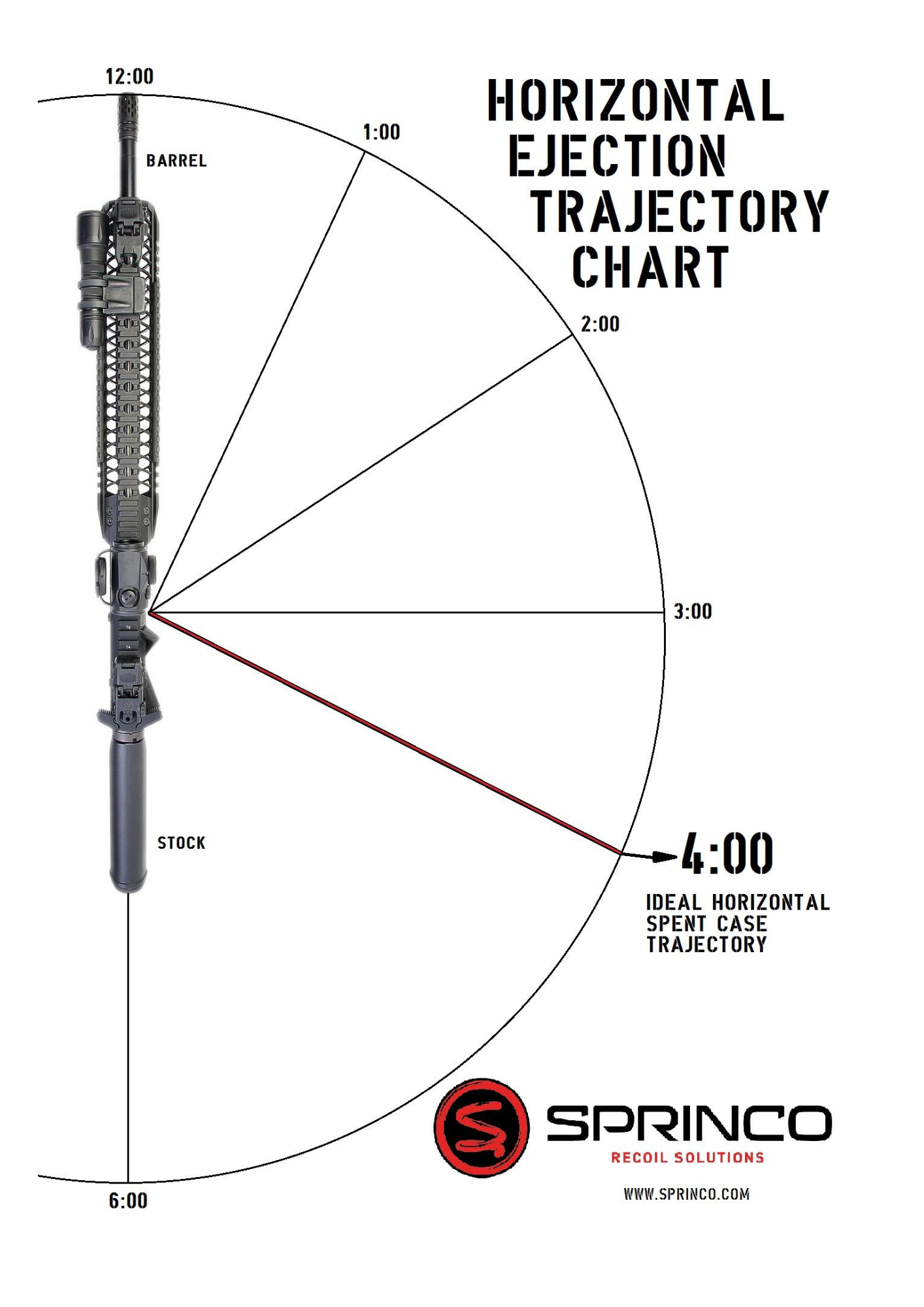Fine Tuning Your Weapon with Sprinco Springs
Posted by Tactical Springs LLC on Apr 10th 2024

The Gas, Mass, & Springs Tuning Method for the AR Platform
Achieving optimal performance characteristics with the AR platform Modern Sporting Rifle is based upon understanding the fundamental operating principles of the weapons system. The three core components to the operations trifecta are, Gas, Mass, and Springs. Or more appropriately, springs, gas and mass, in that order. Achieving operational perfection is dependent on achieving the proper balance between the three and tuning the system in the proper sequence, the “operating trifecta.” All gas operated semi or full automatic firearms, regardless of their particular system of operation, rely principally on springs and gas to function. The amount of reciprocating mass, typically bolt and bolt carrier and in the case of the AR platform, the buffer, when combined with the springs and gas effects the cyclic rate and related function of the weapon.
Springs, specifically the action spring, AKA buffer spring is the heart of the AR’s operating system. The action spring determines, to a large degree, how long the bolt carrier group “BCG” stays locked up in battery, controls the speed of the BCG and buffer, known as the reciprocating mass, slows the mass, and creates the force which returns the BCG into battery. Other springs which play a role in the cycling related function are the magazine spring’s ability to bring the rounds into the proper position for reliable feeding and the hammer return spring, which creates some small amount of resistance in the rearward portion of the BCG’s cycle. Selecting the proper action spring is the first and single most critical step in the weapons tuning trifecta.
In the AR platform, the gas that drives the system has several components which affect operation. First is the port pressure, which is determined by the location of the gas port on the barrel and which, also determines the length of time the gas has to travel to effect operation of the bolt. Next, the size of the gas port, which determines gas volume introduced into the system. And lastly, the barrel length past the gas port, which determines the dwell time, or time that the system is pressurized. The pressure factor of the ammunition being fired is the last variable related to gas. However, it should be noted, that when using suppressors which have backpressure created by the baffle-chamber design most common in the industry, this effectively lengthens the barrel, often dramatically increasing the dwell time and creating additional prolonged pressure on the breach-face of the bolt. These characteristics creates an “over gassed” condition, increased cyclic rate, felt recoil, and blowback into the action. In summary the factors defining the “Gas” leg of the “3 Legged Stool” are the barrel length, gas length, port size, power factor of the loads being fired, different muzzle devices, and if suppressed, the backpressure characteristics of a particular can.
Mass, in this case specifically, the reciprocating mass in an AR platform weapon, which is composed of the cumulative weight of the BCG and buffer, affects the tuning in two key ways. The more weight you have, the longer it takes to begin moving. This helps to keep the BGC in battery in over-gassed and under-sprung systems, and systems prone to early unlocking and prolonged dwell, such as guns with carbine length gas systems and 14 to 16 inch barrels and almost any length system running suppressors with traditional backpressure generating designs. Second, once that mass starts moving, it will move slower the heavier it is, thus slowing the cyclic rate. Sounds good, doesn’t it. Keep the BCG locked up longer and slow the cyclic rate, what’s bad about that? Well, several things, once that heavier mass bottoms out against the bottom of the buffer tube, it remains there longer, since it takes the action spring longer to get that mass moving forward, so you get more felt recoil for a longer duration, which tends to move the weapon more, which makes it more difficult to keep repeat shots on target. Next, ©2015 Tactical Springs LLC
more weight can keep the BCG locked up too long, allowing pressure in the system to drop below what’s needed to properly cycle the action with the result being short stroking and the system being less compatible with lighter loads.
The evolution of the AR platform has blossomed exponentially in the last 26 years, or so. Much of this is due in no small part to the millions of Americans serving in the military since the first Gulf War in August 1990 through September 11 2001 and continuing to the present day with the Global War on Terror. This, combined with the lessons learned in combat drove the need to further develop and improve the AR platform weapons system to meet these evolving requirements.
This has driven the consumer market, and as that market has expanded, the use of the AR platform in competition, hunting, recreation, defense and law enforcement, etc. has presented a bewildering myriad of configurations, calibers, ammunition choices and accessories. All of this has led to a near epidemic level of functional challenges and tuning issues with the platform.
Whether you already have a safe full of guns or are embarking upon a new build, a properly timed and tuned AR platform carbine or rifle will greatly enhance the reliability, shootability and the overall experience with the weapon.
Now that we’ve covered all the basics, the question you most likely have is “what constitutes a properly tuned AR?” and, “how do I get my rifle or carbine tuned to that level?” In short, a properly tuned AR is one that allows the BCG to locks back on last round on an empty magazine and ejects the spent cases at a 4:00 o’clock horizontal ejection trajectory, as referenced from 12:00 o’clock being the bore axis, and 3:00 o’clock being straight out the ejection port.
We call the 4:00 o’clock case trajectory, the brass’ “Happy Place”, with a tight ejection pattern at 4 o’clock being the ultimate indication of both optimal and consistent BCG velocity. Benefits of achieving this highest state of tune, in addition to having your brass in a nice little pile, is greatly enhanced reliability, less felt recoil, gun runs considerably cleaner (especially in suppressed DI guns), reducing maintenance, faster follow up shots and often increased accuracy from more consistent feeding and return to battery.
The other ejection areas are 3 o’clock, which is indicative of a slightly over-gassed or under sprung system, or system with too little carrier of buffer mass for the system as configured. Ejection patterns forward of 3 o’clock, 2:30, 2, 1:30 and 1 o’clock are caused by increasing levels of excess gas and/or inadequate action spring and occur when the over accelerated BCG violently ejects the case, which strikes the shell deflector, causing the case to bounce forward. Erratic ejection patterns during rapid fire, or full auto fire are caused by carrier bounce most often in combination with poor timing, but even precisely tuned AR’s exhibit carrier bounce in rapid fire. This is caused when the standard profile urethane bumper can’t absorb the amount of energy in the time duration required and exhibits linear reflectivity. We have upcoming solutions to dissipate a great deal of the linear reflective energy in a more axial manner.
Unfortunately, with the extremely wide variety of AR platform rifles it’s akin to Forrest Gump’s proverbial box of chocolates, “You never know what you’re gonna get.” The state of “over-gassing” by AR platform weapons and component manufacturers and builders was exacerbated by the great ammo ©2015 Tactical Springs LLC
crunch of 2013. This shortage forced many shooters to grab whatever ammunition they could find, and much of the offerings were and remain very low power factor loads. Manufacturers who were gassing their carbines with the proper port size for the higher pressure mil-spec M855 ammunition, were besieged by customer complaints that their guns would not run with the lower powered consumer SAAMI spec ammunition. The easiest fix was to enlarge the port sizes to decrease the amount of customer service issues. While the larger port sizes would cycle this lower pressure ammunition, the shooter firing NATO or mil-spec or higher power factor loads was faced with a greater incidence of over gassed AR’s, making the vast majority of current production carbines and component builds a forensic exercise to properly tune their guns. Over gassed guns are also going to unlock too early, causing the gun to run dirtier and create premature component wear.
We get a lot of calls from folks who are just gathering components to start a new build and want to know what spring they should purchase. Our answer is that neither one of us will know until you build it and shoot it to document behavior. Even 2 guns constructed from ostensibly identical components can end up with a different ideal “recipe” due to components tolerances and “how the stars align”. If they are impatient and are willing to compromise on attaining the very best results, in a few instances we can tell you at least a good starting place from the historical results achieved by other shooters, but nothing is going to be hard and fast due to the multitude of contributing factors.
The starting point is for the shooter to identify and document the baseline ejection trajectory with the freshest mil-spec spring they can, their current buffer, along with the range of ammo that you plan to be firing. If you already own one of our buffer springs or can borrow one from a friend, use that one because it’s going to be a known commodity rather than a “mil-spec” spring of undetermined heritage. It’s best to take a buddy to an outdoor range and have them directly face the ejection port at 3:00 o’clock from a distance of ~10’ and make that determination while the shooter gets into their gun correctly. In the absence of an assistant, take a video from the same vantage point with their phone camera or GoPro. When feasible, the most accurate assessment is a video taken from directly above the shooter looking straight down. Refer to the provided Horizontal Ejection Trajectory Chart. Log the results of your forensic documentation with every combination, then get back to us with your finding in order for us to give you a more knowledgeable recommendation.
If it’s a brand new DI gun (vs. piston), also it’s best to break it in to properly seat the rings prior to conducting the tuning exercise, and if the rings have a lot of mileage on them, go ahead and replace those, seat them properly firing at least 25 - 50 rounds prior to conducting the documentation exercise on a properly cleaned and lubricated weapon.
It’s also best when possible to borrow as wide a range of heavier buffer weights as possible from a fellow shooter and document how the ejection angle changes with the increases with the reciprocating mass. If you have a gun that’s ejecting in the 12:30 to 1:30 range it’s most likely going to be necessary either install an adjustable gas block or a port resizing device such as those found at Black River Tactical to get the gas into a more manageable part of the tuning equation. You’re never going to attain a 4:00 o’clock trajectory by just increasing the mass and spring weight in a grossly over gassed gun ejecting at 12:30 – 1:00 o’clock. In the absence of access to range of heavier buffers, and rather than going out and purchasing each buffer weight. In the event that you are faced with a grossly over gassed gun and install an adjustable block, load several mags with one round apiece and turn down the gas volume one click at ©2015 Tactical Springs LLC
a time until you determine when the BCG will not lock back. Back it open 2 - 3 clicks and conduct your evaluation from that setting.
Sprinco’s new “4:00 O’clock Configurable Buffer Kits” will allow the shooter to both replicate known commercially available buffer weights and even fine tune to a custom weight that’s in between commercial offerings. A half to three quarters of an ounce can make a big difference in dialing it in perfectly vs. the 1.5 oz. jumps with traditional tungsten weights used in commercially available buffers. If the shooter wants to be able to run everything from the cheapest low powered steel case ammo through full power NATO spec loads, they have to decide whether to tune it to 4:00 o’clock with the lowest power factor loads and accept the fact that they’re going to be over gassed with the heavier loads, or determine the best recipe of buffer weight and spring for both ends of the spectrum. The same dilemma exists with the vast majority of suppressors. Typically if the gun is tuned to 4:00 o’clock unsuppressed, the back pressure induced by the can will move it up to the 2:00 o’clock range and it’s going to run dirtier. If you are tuning a lot of guns, once you identify the optimal custom weight for a particular build, we will make you one with that specific custom weight and laser engrave that on that a dedicated buffer. You then use the kit to tune your next gun. With the 3.25” carbine buffer kit, you’ll be able to create 40 different weights, and with the 4” “A5” buffer kit, 70 different weights!
Sprinco currently offers six different carbine springs from Reduced Power to Extra Extra Heavy to address the Spring leg of the “operating trifecta”. Each spring has been designed to address specific load demands, not clones of other commercially available springs. Utilizing Certified Valve Quality ASTM A877 Chrome Silicon along with Dual-Stage Shot Peening, these springs are designed to maintain consistent, reliable operation for several million cycles. As long as you exercise prudent PM, the springs are going to outlast the duty cycle of tons of barrels, extractors, and rifles with no change in performance related to the buffer spring.
If your goal is to end up with the most reliable, consistent, and best shooting gun possible, while this method takes some time and attention to details, the results of an optimally tuned gun are phenomenal.
©2015 Tactical Springs LLC

